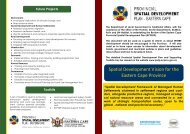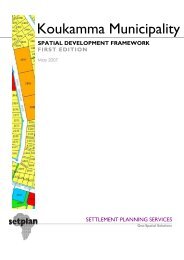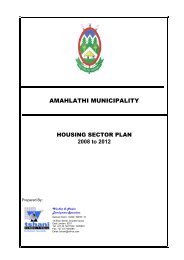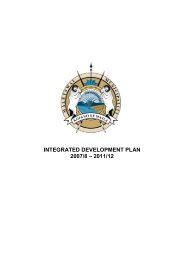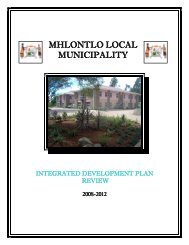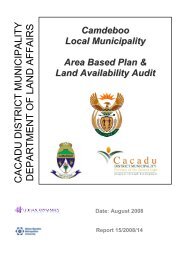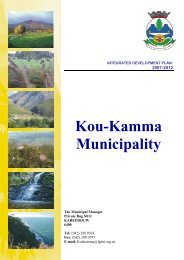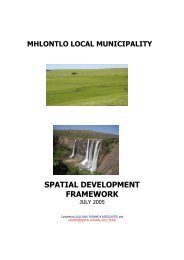Intsika Yethu LM HSP 08_12.pdf - Provincial Spatial Development ...
Intsika Yethu LM HSP 08_12.pdf - Provincial Spatial Development ...
Intsika Yethu LM HSP 08_12.pdf - Provincial Spatial Development ...
Create successful ePaper yourself
Turn your PDF publications into a flip-book with our unique Google optimized e-Paper software.
17<br />
Eliminating the second economy: Without interventions directly addressed at<br />
reducing South Africa‟s historical inequalities, growth is unsustainable.<br />
Interventions to address deep-seated inequalities and that target the<br />
marginalised poor are interventions to bridge the gap with the second economy,<br />
ultimately eliminating the second economy.<br />
Of importance with regards to the governance and institutional interventions, the<br />
framework for the planning and management of land use was highlighted as a key area<br />
for institutional reform. Many investment projects are unnecessarily held up by the<br />
weakness of local or provincial planning and zoning systems, or the cumbersome<br />
Environmental Impact Assessment system. The EIA system is being reformed so that it<br />
will reduce unnecessary delays, without sacrificing environmental standards. A<br />
complimentary activity must be improvements in the planning and zoning systems of<br />
provincial and local governments.<br />
2.4 <strong>Provincial</strong> Housing Policy<br />
2.4.1 <strong>Provincial</strong> Growth and <strong>Development</strong> Plan (PGDP)<br />
The PGDP is a strategic plan for the medium-to-long range (10 year) which prioritises<br />
and addresses major structural deficiencies in the economy and the conditions of<br />
society. The main aim of the Framework Document is to articulate a consensus-based<br />
vision and quantified targets for <strong>Provincial</strong> Growth and <strong>Development</strong> through a clear<br />
strategy framework. This strategy framework will in turn lay the ground for the generation<br />
of policy options.<br />
The need for a strategic approach to growth and development came from the recognition<br />
that a comprehensive strategic response is needed to poverty and the associated<br />
structural constraints to growth and development. Also, it was realised that, while<br />
continued growth of the manufacturing sector is needed, a stronger priority is industrial<br />
diversification, promotion of linkages into other sectors of the economy with growth<br />
potential, and promotion of regional linkages. Manufacturing growth must not be limited<br />
to a modern, export-oriented enclave, but must develop strong supply and value chain<br />
linkages to agriculture and agro-processing. In addition, the agriculture sector has high<br />
growth potential in the former homelands as a source of income and employment.<br />
<strong>Provincial</strong> agricultural resources have to be mobilized to:-<br />
‣ Improve the food security of poor households.<br />
‣ Promote agricultural growth for employment and to provide raw materials for agro<br />
processing and natural resource based industries.<br />
‣ To lay the foundations for economic growth in the rural parts of the Province and<br />
hence change the spatial inequality of growth and development.<br />
Moreover, a third strategic priority is the development of the Province‟s tourism potential,<br />
especially the promotion of community based tourism that will allow for broader<br />
distribution of the benefits of tourism. Tourism development must draw, in a sustainable<br />
manner, on the rich heritage and natural resources in the Province. One of the logical<br />
developments of such a broad strategic approach is the prioritization of different sectors<br />
based on their potential to contribute to poverty eradication and to regional equity in



